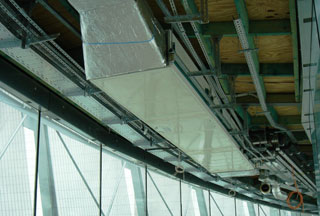
HVAC Air Group in an airlift. Source: Hvac en kabelgoot
Three types of networking topologies are utilized in the Internet-of-Things: point-to-point, star, and mesh networking. To provide a way to explore the attributes and capabilities of each of these topologies, we defined a hypothetical (but realistic) application in the building monitoring and energy management space and methodically defined its networking requirements.
Let’s pull it all together to make a network selection for our building monitoring application. As described previously, the application will monitor, analyze, and optimize energy usage throughout the user’s properties. To accomplish this, monitoring and control points need to be deployed throughout each building, including occupancy and temperature sensors. Sensor data will be aggregated back to a central building automation panel located in each building. A continuous collection of data will provide a higher resolution of temperature and occupancy information, thus rendering better insight into HVAC performance and building utilization patterns. Comparison of energy utilization throughout the portfolio of properties allows lower performing buildings to be flagged.
Requirements summary
The networking requirements for this application are summarized in Table 1.
| Range | Up to 1,000 feet, sensor to gateway. Network coverage of up to 200,000 square feet. |
| Power consumption | Sensor nodes run off battery power for a minimum of one year. |
| Scalability | Up to hundreds of nodes. |
| Bandwidth/data rate | Up to 20 Kbps. |
| Reliability | Very high, mission-critical reliability and network uptime. |
| Interoperability | Based on an open standard allowing interoperability with third-party devices. |
| Availability | Proven technology, established installed base, and multiple sourcing options. |
| Cost | Reasonably low cost, relative to other networking options. |
The attributes and capabilities of each of our three network topologies are summarized in Table 2.
| Attribute | Point-to-point (Bluetooth) | Star (Wi-Fi) | Mesh (Zigbee) |
|---|---|---|---|
| Range | 10 meters (about 30 feet) | 32m (120 feet) indoors, 95m (300 feet) outdoors | Well over 300 meters (1,000 feet) |
| Power Consumption | 2.5 mW. Battery life measured in days | High. Line power required for access point. | Very low. Battery life over two years for sensor nodes. |
| Scalability and flexibility | Two nodes, limited flexibility | 10-15 devices per access point | 100s of nodes per network |
| Bandwidth | 1-3 Mbps | >100 Mbps | 250Kbits/sec |
| Reliability | High | High | High |
| Interoperability | High (with other Bluetooth devices) | High |
High, requiring the same ZigBee app’n profile. Medium in general (due to multiple app’n profiles). |
| Component Availability | Widely available | Widely available | Widely available |
| Cost | $2.50 in qty >2,500 | Complete SoC w/ TCP/IP stack ~ $10 qty >1,000 | ~$4.85 qty >3,500 |
Assessing the building application
We now have the information we need to assess which topology best fits our application requirements. From our review we can see that all three topologies have adequate reliability, interoperability, component availability, and cost. However, the first four attributes in each table — range, power consumption, scalability, and bandwidth — address the core requirements of the application. These four attributes are quite different for each topology. Within this series, the following points were made regarding these networking options:
- Range
- A mesh/Zigbee topology spans broad areas and easily propagates sensor data through its mesh network via multiple hops well over 1,000 feet. Point-to-point (Bluetooth) and Wi-Fi networking did not support this range.
- Power Consumption
- The mesh/Zigbee protocol is designed for very low power consumption. The technology has a very low duty cycle. The network is in a sleep mode most of the time, wakes up at predetermined intervals, sends sensor data, and drops back into sleep mode. This allows sensor nodes to be battery-powered for one to two years between batter replacements. Bluetooth battery life is limited to days and Wi-Fi requires line power.
- Scalability
- The Zigbee network specification states that networks can theoretically scale to thousands of nodes per network. However, realistically, and in practice, Zigbee networks can scale to hundreds of nodes in a single network. Our point-to-point/Bluetooth option is limited to two nodes and Wi-Fi to 15 devices per access point.
- Bandwidth
- All three topologies easily meet the 20 Kbps application requirement. However, the core design center of mesh networks, and specifically Zigbee, is for low data rate applications. Bluetooth’s and Wi-Fi’s capability to stream data at a high rate (3 Mbps and 100 Mbps respectively), draws correspondingly more power, and is overkill for this application.
Our best networking topology choice is therefore a Zigbee mesh networking architecture. The Zigbee standard, as mentioned earlier, has been designed for low power, low data rate networks and has been widely used in residential, building, and industrial automation/control applications.
Looking toward the future
The Internet of Things is in its early stages of development. Networking architectures, protocols, and standards are continuing to evolve on both broad (horizontal) and industry-specific (vertical) fronts.
6LoWPAN is one noteworthy emerging standard that has been designed to allow Internet Protocol data, specifically IPv6 packets, to be sent and received over low-power, low data rate 802.15.4-based mesh networks — the same networks on which the ZigBee protocol operates. A gateway device converts the IPv6 packets into the 6LoWPAN message structure and then back again to IPv6 so that a Wi-Fi device can receive them. Even with the required packet conversion, the 6LoWPAN protocol promises to provide a much tighter integration between 802.11 IP-based Wi-Fi networks and mesh networks designed for small form factor device (“thing”) networking.
